TNAU Agritech Portal :: Crop Protection
Important pests
| I. Borer |
| Stem fly: Atherigona orientalis |
Symptoms of damage
- The maggot feeds on the young growing shoots results in “dead hearts”.
Identification of the pest
- Adult - Small grey coloured fly.
|
 |
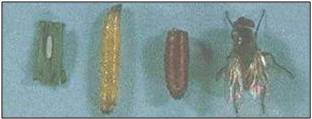 |
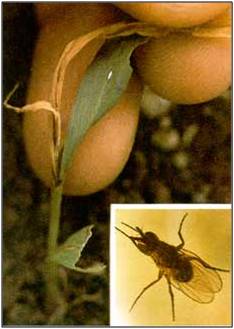 |
| Adult |
Nymph, Larva, Pupa and Adult |
Dead Heart |
|
Management
- Use seeds pelleted with insecticides (see sorghum)
- Seed treatment with imidacloprid 70 WS 10 g/kg of seeds
- Plough soon after harvest, remove and destroy the stubbles.
- Set up the TNAU low cost fish meal trap 12/ha till the crop is 30
days old.
- Soil application of phorate 10%CG 10 kg/ha at the time of sowing
Apply any one of the following insecticides:
- Methyl demeton 25 EC 500 ml/ha
- Carbofuran 3%CG 33.3 kg/ha
- Dimethoate 30%EC 1155 ml/ha
- Methyl demeton 25% EC 1000 ml/ha
- Phorate 10%CG 10 kg/ha
|
Top |
| Stem borer: Chilo partellus |
Symptoms of damage
- Central shoot withers and leading to “dead heart”.
- Larvae mines the midrib enter the stem and feeds on the internal tissues.
- Bore holes visible on the stem near the nodes.
- Young larva crawls and feeds on tender folded leaves causing typical “shot hole” symptom.
- Affected parts of stem may show internally tunnelling caterpillars
|
|
Identification of the pest
- Larva - Yellowish brown with a brown head
- Adult - Moth is medium size, straw coloured
|
 |
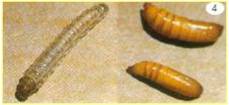 |
 |
|
Larva and Pupa |
Moth |
|
Management
- Mix any of the following granular insecticides with sand to make up
a total quantity of 50 kg and apply in the leaf whorls on the 20th
day of sowing
- Phorate 10% CG10 kg/ha
- Carbaryl 4% G 20 kg/ha.
- For stem borer, release egg p[arasitoid Trichogramma chilonis @
2,50,000 /ha coinciding egg laying period. Three releases at
weekly interval are desirable. Third release is to be accompanied
with larval parasitoid Cotesia flavipes @ 5000/ha
- If granular insecticides are not used, spray any one of the
following :
- Carbaryl 50 WP 1 kg/ha on the 20th day of sowing (500 l of spray
fluid/ha).
- Dimethoate 30% EC 660 ml/ha
|
Top |
| Pink stem borer: Sesamia inferens |
Symptoms of damage
- Pink larva enters into the stem causing dead heart symptom .
Identification of the pest
- Egg - Bead like laid in rows within the leaf sheath
- Larva - Pinkish brown with dark head
- Adult - Straw coloured moth with white wings
Management
- Spray phosaloneb 35%EC at every 20 days interval
|
|
Top |
| II. Earhead feeders |
| Corn worm/Earworm: Helicoverpa armigera |
Symptom of damage
- Larva feeds on silk and developing grains.
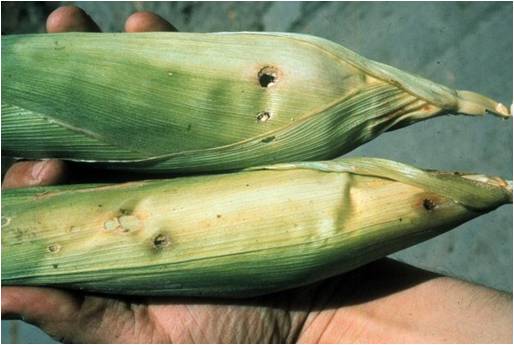
|
| Bore hole on the cob |
|
Identification of the pest
- Eggs - Spherical in shape and creamy white in colour, laid singly
- Larva - Shows colour variation from greenish to brown.
- It has dark brown grey lines on the body with lateral white lines
- Pupa - Brown in colour, occurs in soil, leaf, pod and crop debris
Adult
- Light pale brownish yellow stout moth.
- Forewings are olive green to pale brown with a dark brown circular spot in the centre.
- Hind wings are pale smoky white with a broad blackish outer margin.
Management
- Set up of light traps
- Set up sex pheromone traps at 12/ha
- Two applications of NPV at 10 days interval at 1.5 X1012 POB along with
- Crude sugar 2.5 kg + cotton seed kernel powder 250 g on the ear heads
Apply any one of the following on 3rd and 18th day after panicle emergence :
- Carbaryl 10 D 25 kg/ha
- Malathion 5 D 25 kg/ha
- Phosalone 4 D 25 kg/ha
|
|
|
Top |
| Ear head bug: Calocoris angustatus |
Symptom of damage
- Nymphs and adult suck the juice from within the grains when they are in the milky stage.
- Grains shrink and turn black in colour and ill filled (or) chaffy.
- Orange and pale green nymphs and adults are seen on the ear head.
Identification of the pest
- Egg - Blue cigar shaped , laid under the glumes or into the middle of the florets
- Nymphs - Slender, green in colour
- Adults - Male is green in colour. Female is green with a brown margin
Management
Apply any one of the following on 3rd and 18th day after panicle emergence :
- Carbaryl 10 D @25 kg/ha
- Malathion 5 D @25 kg/ha
- Phosalone 4 D @25 kg/ha
- Neem seed kernel extract 5%
- Azadirachtin 1%
|
|
| III. Leaf feeders |
| Web worm: Cryptoblabes gnidiella |
Symptom of damage
- larva first feeds on the lemma of the flowers scraping the chlorphyll
- later on the milky grains.
- Webbing of maize cobs and feeding on the flowers and the grains.
Identification of the pest
- Larva - Long and dark brown. It forms silken webs on cobs
- Adult - Dark grey forewings
Management
|
 |
Top |
| Ash weevil: Myllocerus sp. |
Symptom of damage
- larva feeds on the secondary roots and adults on leaves.
Identification of the pest
- Adult - Grey coloured weevil.
|

|
Management
- Mix any of the following granular insecticides with sand to make up
a total quantity of 50 kg and apply in the leaf whorls on the 20th
day of sowing
- Phorate 10% CG10 kg/ha
- Carbaryl 4% G 20 kg/ha.
- For stem borer, release egg p[arasitoid Trichogramma chilonis @
2,50,000 /ha coinciding egg laying period. Three releases at
weekly interval are desirable. Third release is to be accompanied
with larval parasitoid Cotesia flavipes @ 5000/ha
- If granular insecticides are not used, spray any one of the
following :
- Carbaryl 50 WP 1 kg/ha on the 20th day of sowing (500 l of spray
fluid/ha).
- Dimethoate 30% EC 660 ml/ha
|
Top |
| IV. Sap feeders |
| Leafhopper: Pyrilla perpusilla |
Symptom of damage
- Leaves become yellow
- Covered with black sooty mould
- Top leaves get dried up and lateral buds germinate
Identification of the pest
- Nymph - Soft, pale brown dorsally and pale orange ventrally
- Adult - Straw coloured, head pointing forward as a snou
|
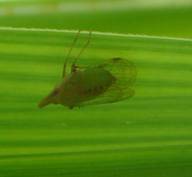 |
Management
- Avoid excessive use of nitrogenous fertilizers
- Set up light trap
- Detrash: 150 and 210th DAP
- Release lepidopteran parasitoid:
- Epiricrania melanoleuca @8000 -10,000 cocoon /ha (or) 8 - 10 lacs egg/ha.
- Spray any one of the following on the 150th and 210th day (1000 l spray fluid)
|
Top |
| Aphid or Plant lice: Rhopalosiphum maidis |
Symptom of damage
- Yellowing of leaves
- Colonies of aphids found in central leaf whorl.
Identification of the pest
- Yellow with dark green legs
|
|
Management
- Mix any of the following granular insecticides with sand to make up
a total quantity of 50 kg and apply in the leaf whorls on the 20th
day of sowing
- Phorate 10% CG10 kg/ha
- Carbaryl 4% G 20 kg/ha.
- For stem borer, release egg p[arasitoid Trichogramma chilonis @
2,50,000 /ha coinciding egg laying period. Three releases at
weekly interval are desirable. Third release is to be accompanied
with larval parasitoid Cotesia flavipes @ 5000/ha
- If granular insecticides are not used, spray any one of the
following :
- Carbaryl 50 WP 1 kg/ha on the 20th day of sowing (500 l of spray
fluid/ha).
- Dimethoate 30% EC 660 ml/ha
|
Top |
| Shoot bug: Peregrinus maidis |
Symptom of damage
- Plants become unhealthy stunted and yellow.
- The leaves wither from top downwards.
- Panicle formation is inhibited and the plants die if attack is severe.
- Honeydew secreted by the bug causes growth of sooty mould on
leaves.
- The midribs of the leaves turn red due to egg-laying and may
dry up subsequently.
|
Identification of the pest
- Egg: Laid inside the leaf tissue and covered with a white waxy substance.
- Adult: Yellowish brown to dark brown with translucent wings.
Management
Spray any following insecticides
- Diazine0.04%
- Dimethoate (or) 0.02%,
- Phosphomidon @ 250 ml in 450-500 litres water/ha
|
|
| Top |
| Updated on Jan, 2023 |
|
|

